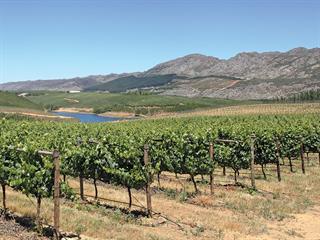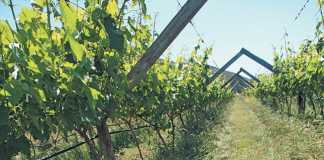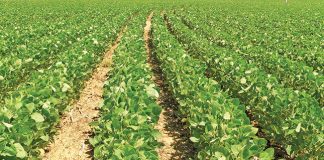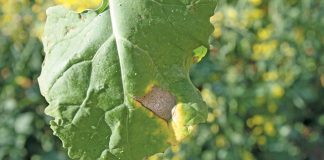
Wines produced from grapes grown on the Ceres Plateau, such as De Grendel’s Op die Berg, have won accolades in recent years and swiftly built a reputation for excellent quality. Yet this achievement has been built on a small output; only about 40ha are currently under vineyards in the region, which is known primarily for its apples.
As long as apple growing is more lucrative than wine grape production, the latter will remain a sideline, according to Kallie du Plessis, farm manager of Dennekruin, which supplies De Grendel with wine grapes.
“Vineyard establishment and production costs are only a third of that of apple production per hectare in the Witzenberg Valley. But gross income per hectare is almost three times higher for apples than for wine grapes. With production averaging around 70t/ ha, Witzenberg Valley is one of the best apple-producing regions in the world,” he explains.
Planting vineyards here would only make business sense on a farm that had a shortage of water, admits Kallie, as vineyards use less than a third of the volume of water than apple orchards.
The beginnings
Farmers in the Witzenberg Valley started producing wine grapes about 15 years ago, when Distell decided to source wine from the region.
“At the time, Distell visited various farms to identify high-potential soils for vineyards production. They also offered to finance the establishment of the vineyards in return for the supply [of grapes],” Kallie recalls.

Hendri Carstens (left) and Kallie du Plessis see themselves as apple producers who also work with vineyards.
Distell’s decision made sense, as the Witzenberg Valley is situated above 960m and its cold winters are well suited to wine production. But these conditions also make the region ideal for apples, and the 30ha on Dennekruin which Distell earmarked for wine grape production also has prime soil for apple production.
Despite these factors, Pieter Graaff, owner of Witzenberg Properties, of which Dennekruin forms part, went ahead and planted his first vineyards on Dennekruin in 2005. He decided to plant the vineyards at his own expense as he did not want to become dependent on Distell.
“The reasoning was that the wine grapes would help to extend our labour season. It failed to meet this objective, however, as the grapes ripened much later than anticipated, right at the start of the apple season around the last two weeks of February and start of March,” Kallie says.
Onion production later proved to be a better way to expand the labour season. The farm currently has 237ha under apples, 33ha under pears, 3ha under peaches, 10ha under vineyards, and 30ha under onions.
“However, we didn’t get rid of the vineyards and they’re now part of our production package,” he says. “We have Chardonnay, Pinot Noir and Sauvignon Blanc varieties. There used to be a block of Merlot, but we replaced it with Chardonnay, because the Merlot grapes reached optimal ripeness too deep into our peak time for apple harvesting.”
According to Kallie, the fact that the farm has such a small area under wine production is a significant advantage, as it allows him to make the required interventions at the right time.
“We employ a total of 70 permanent and 320 seasonal workers. Unlike a large wine farm where there are more than 50ha of grapes in production, we have the luxury of quickly sending a few of our workers in to do interventions at the required time without really disrupting other farming activities,” he explains.
Picking, for example, is done only once in each block. “It takes our workers on average three hours to pick a block. The same applies to weeding, pruning and spraying, for example.”
The vineyards also require less attention and fewer interventions than the apple orchards. Hendri Carstens, who is in charge of the vineyards, admits that he was unfamiliar with technical jargon used in vineyard production when starting out on Dennekruin, and even today they simply follow the advice received from the wineries they supply – De Grendel and Boschendal – and VinPro agricultural consultants.
Lessons learned as apple producers
The team at Dennekruin had a distinct advantage when experimenting with wine grapes: a careful, precise approach to all aspects of production honed by years of working with apples.
“When you produce apples, you have to pay a lot of attention to detail to produce fruit of the right size and colouration. This work ethic is carried over to the vineyards, which are actually less labour-intensive.
“When it comes to pruning, experienced workers carry out the fine work, while less experienced workers do heavier work,” Hendri says.
The grapes are grown on a traditional vertical trellis system with a single wire that can be moved up or down as the foliage grows.
Pest control
Hendri says that weevils, which are also a problem in apple orchards, are their greatest pest risk. Fungal diseases such as downy mildew and white rust do not pose a problem, however, as the vineyards are isolated. Pesticide is applied twice in winter for mealy bugs and a further six times during the rest of the year to prevent fungal diseases.
“Organic certification doesn’t justify its cost. Our production only averages around 8t/ ha,”Kallie says. He would like to increase production to 12t/ha as this would make the vineyards more profitable.
Phone Kallie du Plessis on 023 313 3108 or email him at [email protected].













